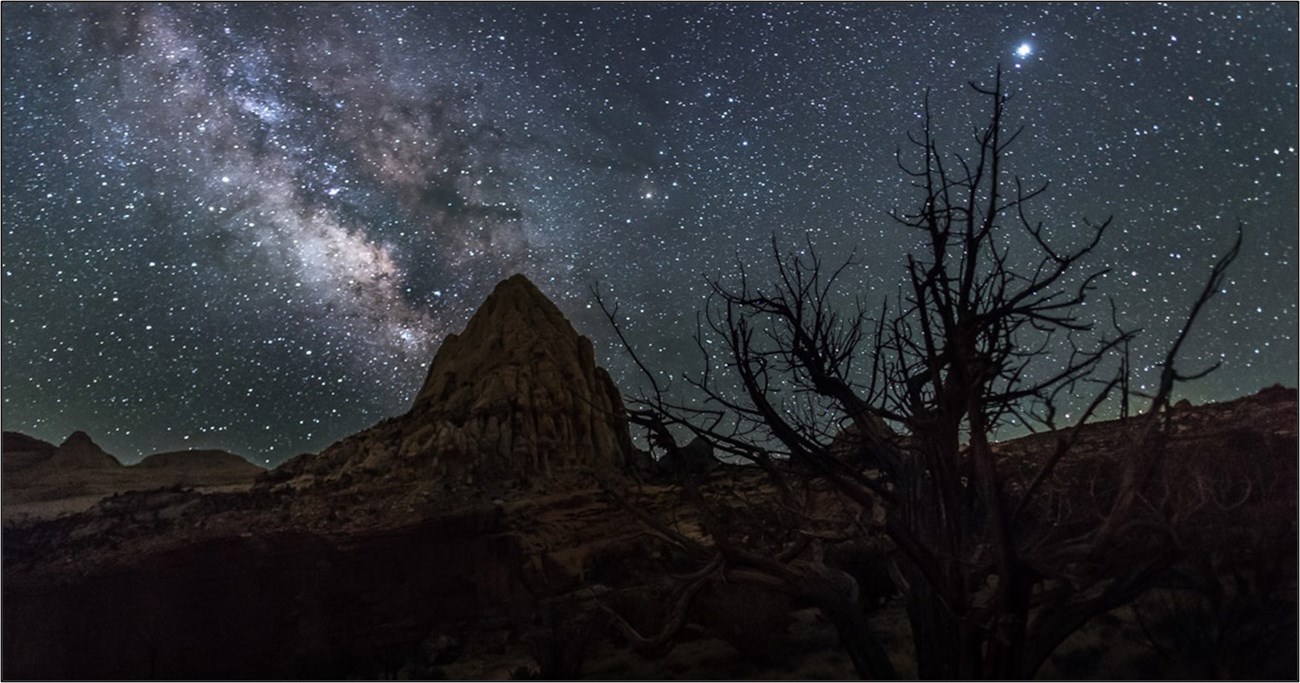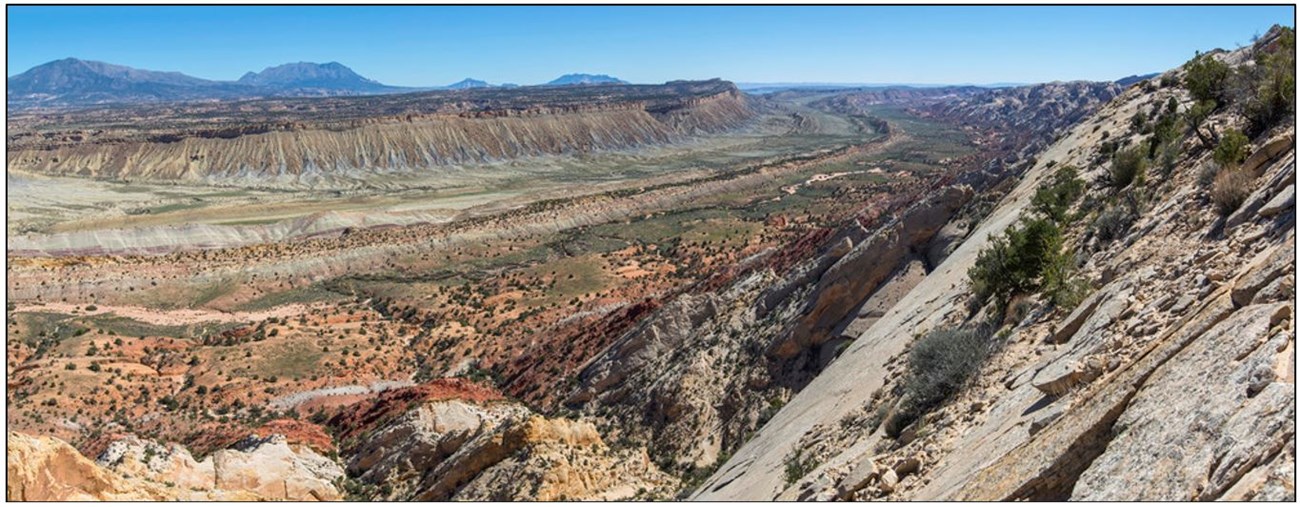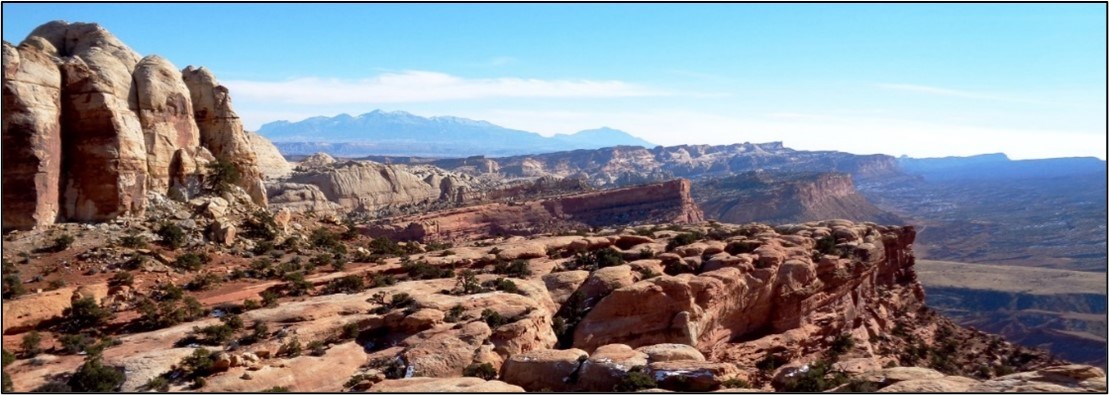Part of a series of articles titled NRCA 2022: Condition of Selected Natural Resources at Capitol Reef.
Article
Assessing Night Skies, Air Quality, and Scenic Views at Capitol Reef

Photo © Zoltan G. Levay
Capitol Reef National Park (NP) has some of the darkest night skies in the country, and its daytime scenic views are colorful and expansive. Capitol Reef is situated in the Colorado Plateau region of south-central Utah, approximately 220 miles southeast of Salt Lake City. It encompasses an area of approximately 381 square miles, nearly all of which is managed for its rugged and remote wilderness value. The landscape is carved by wind and water, offering spectacular vistas of colorful geologic features, exceptional dark night skies, and diverse habitats.
The park was designated an International Dark Sky Park in 2015 by the International Dark-Sky Association. It achieved the designation because of the natural dark skies and the park’s commitment to reducing light pollution and educating the public about night skies. As part of the designation, park staff monitor night sky conditions throughout the park.
The importance of night skies, scenic views, and air quality
Dark night skies, scenic views, and air quality are all valuable resources the NPS protects in national park units. In addition to inspiring people for generations, dark night skies enhance the experience of solitude and wilderness character that park visitors seek. Wildlife are also adapted to natural darkness and therefore depend on dark night skies for their health and survival. Similarly, scenic views contribute to a visitor’s ability to connect with nature and to appreciate the beauty or grandeur of a particular park.
Air quality, critically important because we breathe the air, also affects the clarity and quality of our night skies and scenic views. Clean air also keeps park ecosystems healthy, for example, by minimizing harmful atmospheric nitrogen and sulfur deposition that can acidify soil and water. It is precisely because these resources are so connected that managers at Capitol Reef NP want to integrate monitoring for night skies, air quality, and scenic views.

NPS Photo
What can affect these resources?
Air quality, night skies, and scenic views can be impacted by regional (or external) and local (or within the park) sources of air pollution. Regional sources include:
- Pollution (such as from vehicle exhaust, coal-fired power plants, oil and gas development)
- Wildfire
- Dust from agriculture and other land disturbances
Local sources include:
- Vehicle use (vehicle exhaust, including idling cars and buses)
Scenic views can also be affected by the appearance of built structures, such as roads, fences, powerlines, and buildings. Night skies can also be affected by lighting from nearby and more distant communities, park lighting (although the vast majority of lights meet International Dark-Sky Association standards), and nighttime traffic.
With regards to lighting from nearby communities, learn what the neighboring community of Torrey, Utah, is doing to protect the dark night skies over Capitol Reef. Torrey was designated a Dark Sky Community in 2018.
Assessing conditions of the night sky, air quality, and scenic views at Capitol Reef
A recent Natural Resource Condition Assessment (NRCA) through the NPS NRCA Program focused on a number of resources in Capitol Reef NP, including night sky and air quality; scenic views were not directly assessed in the study. NRCAs evaluate natural resource conditions so that parks can use the best available science to manage their resources. To assess condition of the night sky, ecologists at Utah State University (USU; our partner for the project) used four indicators with seven different measures:
- two measures of illuminance (the amount of light falling upon a surface),
- two measures of luminance (the brightness of a surface),
- one measure that describes the amount of anthropogenic (human-related) light pollution, and
- two measures of sky quality (one using the Bortle Dark-Sky Scale, and the other, limiting magnitude (based on noting the magnitude of the faintest star visible to the naked eye).
Data for the assessment were collected by Capitol Reef NP staff and the NPS Natural Sounds and Night Skies Division at 14 locations throughout the park. To assess the condition of the park’s air quality, USU ecologists used two indicators:
- daytime visibility (haze index), and
- ozone (as related to human health).
Although haze is a measure of daytime visibility, it also influences the visibility of stars and planets in the night sky. The haze index is a measure of aerosol particles in the atmosphere. Information for this indicator came from the NPS Air Resources Division (ARD). The indicator is monitored through the Interagency Monitoring of Protected Visual Environments (IMPROVE) Program, and there is an IMPROVE monitor station located within the park.
The air quality ozone indicator is monitored across the U.S. by networks operated by the NPS, U.S. Environmental Protection Agency (USEPA), states, and others. NPS ARD obtains the ozone data from the USEPA Air Quality System database.
What did we learn?
-
Overall, the indicators of night sky condition are good, and the indicators of air quality condition are fair.
-
Of the four indicators for night sky, three were rated as “good” – luminance, anthropogenic light pollution, and sky quality — and one was rated as “good/fair” — illuminance. Trends for two indicators were stable, and trends for two were unknown due to a lack of data.
-
The first indicator for air quality, daytime visibility, was found to be “fair,” and the 10-year visibility trend was unchanged. Confidence in the condition was high because there is a monitoring station in the park.
-
In 2018, the measured visual range at Capitol Reef was 86 to 179 miles. Without the effects of pollution, the estimated visual range would be 127 to 197 miles. Although the condition for the first air quality indicator (haze index) is fair—a common occurrence across the Colorado Plateau region—night skies at the park are of high quality.
-
The second indicator for air quality (ozone), was also found to be fair. The trend is unknown because there are not sufficient on-site or nearby ozone monitoring data for the park.
-
As park visitation increases, which it has in recent years (the number of visitors in 2019 was more than double that in 2008 [1,226,500 people compared to 604,800 people]), the number of vehicles in the park also increases. This could increase ground-level ozone levels in the park.
-
It's expected that air quality, and therefore visibility, will improve because the largest coal-fired power plant in the western U.S., the Navajo Generating Station, south of the park, was decommissioned in 2019.

NPS Photo
What can park managers do with this information?
The results of this study can be used to inform park planning and management actions that involve the night sky, scenic views, and air quality. A number of ideas, opportunities, or needs emerged from the assessment process to benefit these park resources.
- One need identified is to evaluate scenic views in the park, and to integrate the routine monitoring of scenic views along with night sky and air quality.
- The assessment process also pointed out the opportunity to work with partners, such as Wayne County, on future development lighting to help maintain the dark night sky in the park and the surrounding region.
- There may be opportunities for citizen-science projects in the park, such as citizen-science photo stations for tracking haze and landscape changes in the park.
- The assessment also highlighted a remaining gap in our information—what is the amount of pollution from vehicle exhaust within the park and from off-road recreation on lands adjacent to the park (from exhaust and dust)?
There’s so much more to learn about the night sky at Capitol Reef NP!
Information in this article was summarized from: Struthers K and Others. 2022. Natural resource conditions at Capitol Reef National Park: Findings & management considerations for selected resources. Natural Resource Report. NPS/NCPN/NRR—2022/2406. National Park Service. Fort Collins, Colorado. https://doi.org/10.36967/nrr-2293700
Last updated: July 14, 2022
